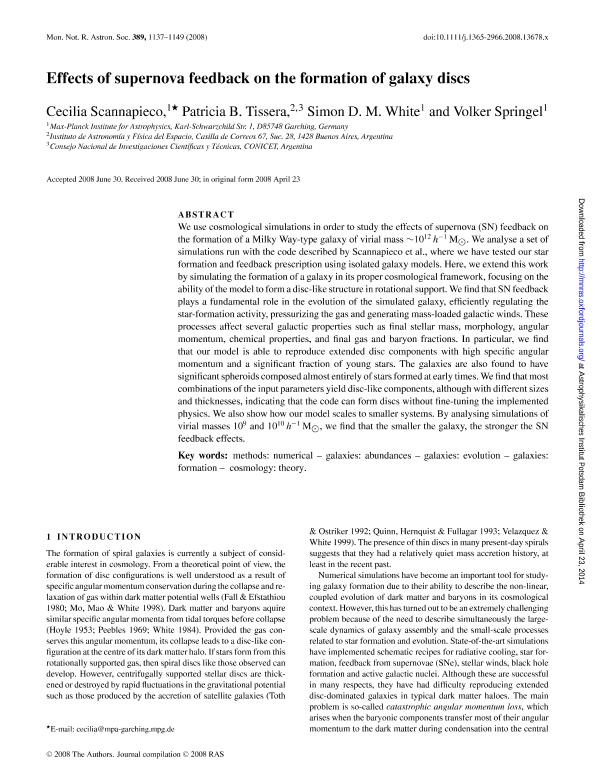Mostrar el registro sencillo del ítem
dc.contributor.author
Scannapieco, Cecilia

dc.contributor.author
Tissera, Patricia Beatriz

dc.contributor.author
White, Simon D.M.
dc.contributor.author
Springel, Volker
dc.date.available
2017-08-01T17:55:44Z
dc.date.issued
2008-09
dc.identifier.citation
Scannapieco, Cecilia; Tissera, Patricia Beatriz; White, Simon D.M.; Springel, Volker; Effects of supernova feedback on the formation of galaxy discs; Wiley Blackwell Publishing, Inc; Monthly Notices of the Royal Astronomical Society; 389; 3; 9-2008; 1137-1149
dc.identifier.issn
0035-8711
dc.identifier.uri
http://hdl.handle.net/11336/21720
dc.description.abstract
We use cosmological simulations in order to study the effects of supernova (SN) feedback on the formation of a Milky Way-type galaxy of virial mass ∼1012 h−1 M. We analyse a set of simulations run with the code described by Scannapieco et al., where we have tested our star formation and feedback prescription using isolated galaxy models. Here, we extend this work by simulating the formation of a galaxy in its proper cosmological framework, focusing on the ability of the model to form a disc-like structure in rotational support. We find that SN feedback plays a fundamental role in the evolution of the simulated galaxy, efficiently regulating the
star-formation activity, pressurizing the gas and generating mass-loaded galactic winds. These processes affect several galactic properties such as final stellar mass, morphology, angular momentum, chemical properties, and final gas and baryon fractions. In particular, we find that our model is able to reproduce extended disc components with high specific angular momentum and a significant fraction of young stars. The galaxies are also found to have significant spheroids composed almost entirely of stars formed at early times. We find that most combinations of the input parameters yield disc-like components, although with different sizes and thicknesses, indicating that the code can form discs without fine-tuning the implemented physics. We also show how our model scales to smaller systems. By analysing simulations of virial masses 109 and 1010 h−1 M, we find that the smaller the galaxy, the stronger the SN feedback effects.
dc.format
application/pdf
dc.language.iso
eng
dc.publisher
Wiley Blackwell Publishing, Inc

dc.rights
info:eu-repo/semantics/openAccess
dc.rights.uri
https://creativecommons.org/licenses/by-nc-sa/2.5/ar/
dc.subject
Methods:Numerical
dc.subject
Galaxies:Abundances
dc.subject
Galaxies:Evolution
dc.subject
Galaxies:Formation
dc.subject
Cosmology:Theory
dc.subject.classification
Astronomía

dc.subject.classification
Ciencias Físicas

dc.subject.classification
CIENCIAS NATURALES Y EXACTAS

dc.title
Effects of supernova feedback on the formation of galaxy discs
dc.type
info:eu-repo/semantics/article
dc.type
info:ar-repo/semantics/artículo
dc.type
info:eu-repo/semantics/publishedVersion
dc.date.updated
2017-08-01T14:05:46Z
dc.journal.volume
389
dc.journal.number
3
dc.journal.pagination
1137-1149
dc.journal.pais
Reino Unido

dc.journal.ciudad
Londres
dc.description.fil
Fil: Scannapieco, Cecilia. Gobierno de la Republica Federal de Alemania. Max Planck Institut Fur Astrophysik; Alemania. Consejo Nacional de Investigaciónes Científicas y Técnicas. Oficina de Coordinación Administrativa Ciudad Universitaria. Instituto de Astronomía y Física del Espacio. - Universidad de Buenos Aires. Facultad de Ciencias Exactas y Naturales. Instituto de Astronomía y Física del Espacio; Argentina
dc.description.fil
Fil: Tissera, Patricia Beatriz. Consejo Nacional de Investigaciónes Científicas y Técnicas. Oficina de Coordinación Administrativa Ciudad Universitaria. Instituto de Astronomía y Física del Espacio. - Universidad de Buenos Aires. Facultad de Ciencias Exactas y Naturales. Instituto de Astronomía y Física del Espacio; Argentina
dc.description.fil
Fil: White, Simon D.M.. Gobierno de la Republica Federal de Alemania. Max Planck Institut Fur Astrophysik; Alemania
dc.description.fil
Fil: Springel, Volker. Gobierno de la Republica Federal de Alemania. Max Planck Institut Fur Astrophysik; Alemania
dc.journal.title
Monthly Notices of the Royal Astronomical Society

dc.relation.alternativeid
info:eu-repo/semantics/altIdentifier/doi/http://dx.doi.org/10.1111/j.1365-2966.2008.13678.x
dc.relation.alternativeid
info:eu-repo/semantics/altIdentifier/url/https://academic.oup.com/mnras/article-lookup/doi/10.1111/j.1365-2966.2008.13678.x
Archivos asociados
